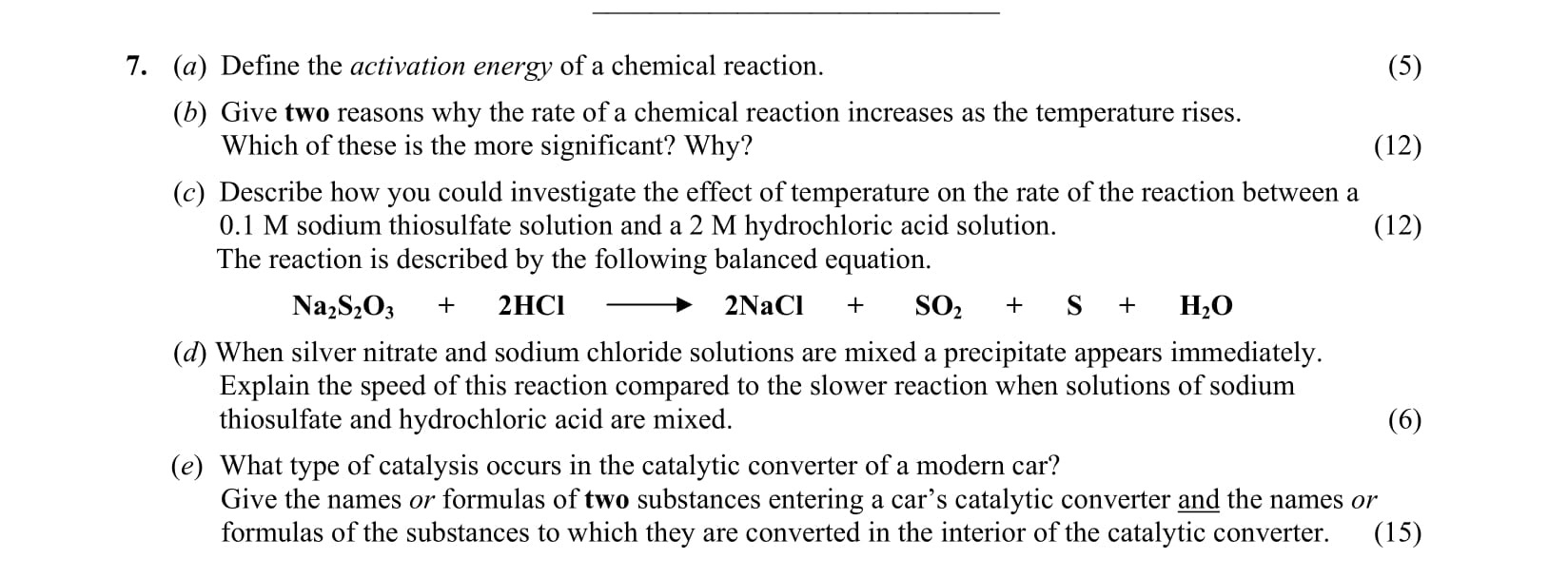Photo AI
7. (a) Define the activation energy of a chemical reaction - Leaving Cert Chemistry - Question 7 - 2006
Question 7

7. (a) Define the activation energy of a chemical reaction. (b) Give two reasons why the rate of a chemical reaction increases as the temperature rises. Which of ... show full transcript
Worked Solution & Example Answer:7. (a) Define the activation energy of a chemical reaction - Leaving Cert Chemistry - Question 7 - 2006
Step 1
Step 2
Give two reasons why the rate of a chemical reaction increases as the temperature rises. Which of these is more significant? Why?
Answer
-
Increased Energy of Collisions: As temperature rises, the kinetic energy of particles increases. This leads to more frequent collisions between reactant molecules, resulting in a higher reaction rate.
-
Increased Effective Collisions: With higher temperature, more collisions reach the necessary activation energy, which enhances the probability of successful reactions.
The first reason is generally considered more significant as it directly contributes to the frequency of collisions, while the second reason contributes to the effectiveness of those collisions.
Step 3
Describe how you would investigate the effect of temperature on the rate of the reaction between a 0.1 M sodium thiosulfate solution and a 2 M hydrochloric acid solution.
Answer
To investigate the effect of temperature,
- Prepare several test tubes containing equal volumes of 0.1 M sodium thiosulfate solutions at different controlled temperatures (e.g., 10°C, 20°C, 30°C, etc.).
- Add a fixed volume of 2 M hydrochloric acid solution to each test tube and immediately start a timer.
- Observe the time taken for the solution to turn cloudy (indicating sulfur precipitation).
- Record the times and compare how the rate of reaction varies with temperature.
Step 4
When silver nitrate and sodium chloride solutions are mixed, a precipitate appears immediately. Explain the speed of this reaction compared to the slower reaction when solutions of sodium thiosulfate and hydrochloric acid are mixed.
Answer
The reaction between silver nitrate and sodium chloride occurs almost instantaneously because it forms a solid precipitate (silver chloride) as soon as the reactants come into contact. In contrast, the reaction between sodium thiosulfate and hydrochloric acid is slower because it involves the formation of sulfur and other products, which requires more time for the reaction process to complete and is influenced by factors such as temperature and concentration.
Step 5
What type of catalysis occurs in the catalytic converter of a modern car?
Answer
The type of catalysis that occurs in catalytic converters is known as heterogeneous catalysis, where the reactants are in a different phase (gas) than the catalyst (solid).
Substances entering the catalytic converter:
- Carbon monoxide (CO)
- Hydrocarbons (correct formula, e.g., C_nH_m)
Substances converted in the interior of the catalytic converter:
- Carbon dioxide (CO2)
- Water (H2O)
- Nitrogen (N2) (when nitrogen oxides are involved)
